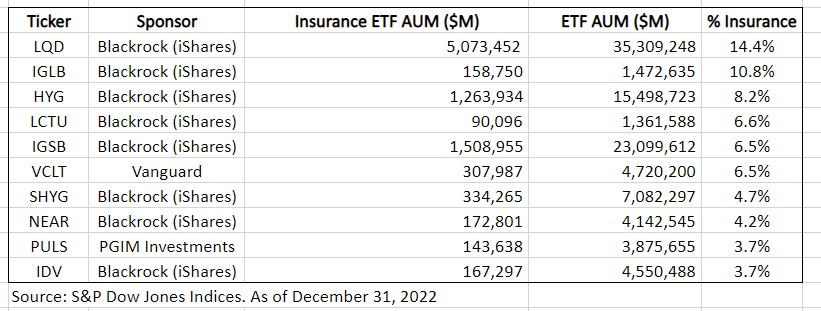As of year-end 2022, U.S. insurance companies invested $37 billion in ETFs. This represented only a fraction of the $6.5 trillion in U.S. ETF assets under management and the $7.9 trillion in invested assets of U.S. insurance companies, according to a just-released report from S&P Dow Jones Indices. Despite representing a small slice of the ETF market, insurance companies are large owners of some widely held ETFs. This ownership, particularly of fixed income ETFs, helps to support liquidity for all investors.
According to data from S&P Dow Jones Indices, insurance companies owned 5% or more of the assets of six U.S.-listed ETFs. Five of those funds were corporate bond ETFs.
See more: Chart of the Week: Investment-Grade Bond ETFs Appeal to Advisors
“There is a robust trading ecosystem that has developed around corporate ETFs,” explained Raghu Ramachandran, head of the Insurance Asset Channel at S&P Dow Jones. “This has increased the liquidity in these ETFs and thus has made trading in these products cheaper. The bid-ask on an ETF is typically much lower than its underlying bonds. We have seen that in periods of market stress, ETFs tend to have more liquidity as cash bond trading volume decreases.” Market stress was certainly underway in 2022.
iShares Fixed Income ETFs Widely Held by Insurers
The iShares iBoxx $ Investment Grade Corporate Bond ETF (LQD) was the most popular ETF with insurance companies. Indeed, the institutional segment held 14% of its year-end 2022 assets. LQD has an average duration of 8 years. Its assets are primarily split between A- (45% of assets) and BBB-rated (46%) corporate bonds.
At the end of last year, insurance companies had more assets invested in the iShares 1-5 Year Investment Grade Corporate Bond ETF (IGSB) than in the iShares 10+ Year Investment Grade Corporate Bond ETF (IGLB). That said, the nearly $160 million of IGLB’s assets owned by insurers represented 11% of the fund’s total assets. Meanwhile, insurance companies hold a more modest 6.5% stake in IGSB, though it is worth approximately $1.5 billion.
IGLB’s average duration of 13 years makes the ETF far more sensitive to the rising interest rates experienced in the first half of 2023 than IGSB. However, if the last rate hike of the cycle has indeed occurred, IGLB might be more appealing going forward.
Insurance Companies Own Large Stakes of Popular ETFs
The iShares iBoxx $ High Yield Corporate Bond ETF (HYG) was also widely held by insurance companies looking to take on credit risk. The institutional client base owned just over 8% of the fixed income ETF’s $15 billion in assets. Bonds rated BB comprise approximately half of HYG’s assets. Most of the rest incur even more credit risk.
Vanguard’s Long-Term Bond ETF Included in Top 10
The Vanguard Long-Term Corporate Bond ETF (VCLT), which is a peer to IGLB, was also disproportionately owned by insurers. At year end, such firms had holdings of approximately $310 million in the fund, equal to 6.5% of its asset base.
Insurers owned more than 5% of just one equity ETF, the BlackRock U.S. Carbon Readiness ETF (LCTU). The actively managed fund owns companies well-positioned for a low carbon economy. At year end, insurance companies owned 6.6% of its assets.
In his research piece, Ramachandran noted that 2022 was the first significant drop in ETF assets under management in insurer ETF usage since the companies started using ETFs. However, for some ETFs, the insurance base still represents key owners.
For more news, information, and analysis, visit the Institutional Income Channel.

